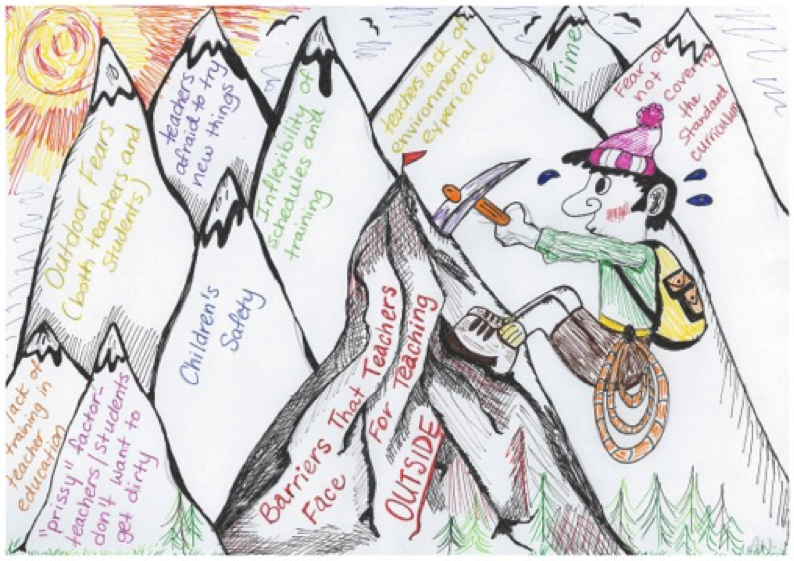Challenges to Outdoor Learning
While learning outdoors was our only option until modern times, a shift inside into classrooms has resulted in misperceptions about the difficulty of implementing lessons outdoors. In terms of barriers or challenges to outdoor learning, there are two critical considerations: factors that influence the provision of outdoor learning, and factors that influence the nature and quality of young people’s learning in outdoor settings. Here, we want to focus on what affects the provision of these lessons.
The provision of outdoor learning is frequently affected by perceived barriers to outdoor learning experienced by those in the teaching profession. In A Review of Research on Outdoor Learning, a number of barriers are identified, including:
- Fear and concern about health and safety
- Teachers’ lack of confidence in teaching outdoors
- School and university curriculum requirements limiting opportunities for outdoor learning
- Shortages of time, resources and support
- Wider changes within and beyond the education sector
In addition, it is suggested that, “Outdoor teaching was not perceived as ‘real’ teaching and there were impediments to going outside. Planning for outdoor classes was seen as more complex than planning for ordinary lessons and teachers reported the time pressures resulting from increased external syllabus changes” (Rickinson et al, 2004, p. 36). In spite of these perceptions, outdoor learning offers rich opportunities for teaching and learning, and for increased student engagement.

A visual representation of perceived barriers to teaching outside by Amanda Nearing
Take it Outside: From Barriers to Benefits
Numerous studies have pointed to the positive cognitive impacts of learning outdoors. By providing a contrast to traditional formal learning indoors, it is possible to find yourself teaching to a more engaged group of students. According to Richardson et al., “…the most important impacts of learning in school grounds/community settings include greater confidence, renewed pride in community, stronger motivation toward learning, and a greater sense of belonging and responsibility” (6). In other words, students become more active participants in their own education.
One of the respondents to the study implemented by Sue Waite noted, “When children learn outdoors, particularly in environments away from the school they often seem more able to become fully involved in the activity and develop a necessary confidence to cope, knowing that the security of the familiar classroom is not there. Facing new challenges and overcoming obstacles, the children develop a greater self-awareness” (6).
Learning outdoors has the potential to address broader aims for education, including:
- Physical wellbeing
- Emotional and social wellbeing
- Different types of learning, including increased creativity
- Environmental education and awareness of sustainable practices
Think back to your own childhood, and the lessons that made the greatest impact on you. Chances are, these lessons took place outdoors. Whether it was writing poetry in a school garden, releasing salmon fry into a local stream or river, or learning about seasonal changes connected to school trees.
We shouldn’t think of a blunt division between indoor and outdoor learning, but rather that these two types of lesson delivery can complement one another and work in tandem. Taking students outdoors shouldn’t be reserved for physical education, recess, or lunch breaks. Instead, lessons about math, science, the arts – almost any lesson you are trying to teach can be formatted to be delivered outdoors. For more on this, please see the Curriculum Connections section.
Teacher & Student Involvement in New Projects
We have explored what might affect the provision of outdoor learning, as well as what benefits teachers will encounter by bringing students outside. Now it is time to consider what can affect the nature and quality of learning in outdoor settings. Clearly, the design of effective outdoor learning spaces is crucial here – poorly designed outdoor learning spaces will negatively affect the nature and quality of the lessons taught outdoors.
In order to mitigate this, teachers and students ought to be actively involved in any new design projects on the school grounds. By being involved from the beginning, teachers will foster new curriculum connections; increased morale and enthusiasm for teaching; new reasons to go outside; increased engagement and enthusiasm for learning; reduced discipline and classroom management problems (Cited in Rickinson et al, 2004, p. 34). In this way, the spaces that are designed will actively support the teaching of outdoor lessons.
Student involvement in new projects will encourage a deeper connection to their school and community. According to Rickinson et al., “There is significant evidence that social development and greater community involvement can result from engagement in school grounds projects. Students develop more positive relationships between themselves, their teachers and the wider community through participating in school grounds improvements. There is also evidence that such projects result in more positive parental participation in their children’s learning” (41).
Students and teachers can (and should) be engaged both in the initial planning phases and the construction and maintenance of elements such as school gardens. Teachers are encouraged to take their students through the “Know Your School” student exercise in order to collect ideas and observations directly from their students. In addition, teachers and students should be encouraged to participate in any design workshops. After all, they will be important end users of the project. A successful project that engages teachers from the beginning will ultimately work to break down barriers to outdoor learning.
If teachers can share what elements will encourage and foster a desire for teaching outdoors, these design moves can be incorporated into the project. Examples include specific elements that link to curriculum objectives, gathering spaces, and weather shelters.
